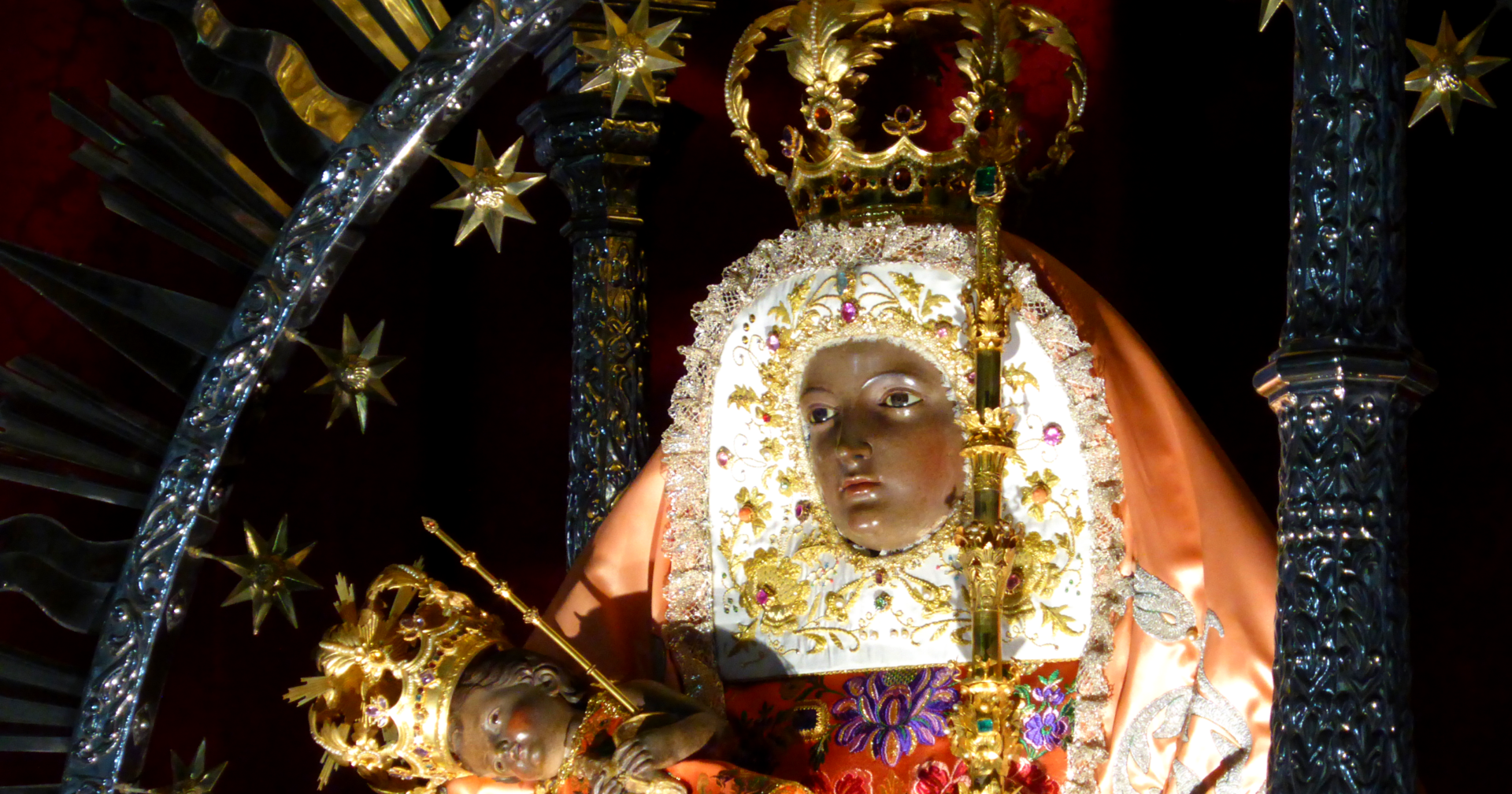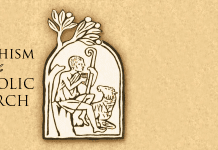Why is today, the Feast of the Presentation of the Lord, also known as Candlemas?
According to pious legend recorded by a Spanish priest, the first historian of Tenerife in the Canary Islands, a statue was discovered on a beach with a child in one hand and a candle in the other in 1392.
A goatherder tried to throw a stone at the statue, but his arm became paralyzed. When another tried to stab it, they ended up stabbing themselves.
The statue was brought to the Cave Shrine of Chinguaro, now a Roman Catholic Church, where it was identified as a statue of the Virgin Mary by a convert. It was later brought to another cave for veneration, the Cave of Saint Blaise, a chapel today.
In 1497, coinciding with the Feast of the Presentation of Our Lord, the first Mass of the feast of the Virgen de Candelaria was celebrated there – Candlemas(s).
The “Virgin of Candelaria” was later declared patroness of the Canary Islands by Pope Clement VIII in 1559, widely petitioned to pray for protection against epidemics, plagues, droughts, and volcanic eruptions.
Owing to its mysterious origin are strange letters on the original statue that was discovered on a beach in 1392, their meaning completely unknown to this day. What do you think they mean?
Band on the neck: ETIEPFSEPMERI
In the belt: NARMPRLMOTARE
On the left sleeve, by the candle: LPVRINENIPEPNEIFANT
In the mantle, in the right arm: OLM INRANFR IAEBNPFM RFVEN NVINAPIMLIFINVIPI NIPIAN
At the edge of the left hand: FVPMIRNA ENVPMTI EPNMPIR VRVIVINRN APVIMFRI PIVNIAN NTRHN
At the bottom of the robe: EAFM IRENINI FMEAREI
On the back of the cape: NBIMEI ANNEIPERFMIVIFVF
In the Philippines, the Virgin of Candelaria is also venerated as Our Lady of the Candles, patroness of the Western Visayas and Romblon.
At the Jaro Cathedral of Oloilo City in the Western Visayas, also known as the National Shrine of the Our Lady of Candles, is an enshrined image which was crowned in person by Pope Saint John Paul II in 1981.
This was the first Marian image to be canonically crowed by the pope in person in all of Asia and the Philippines.
Our Lady of Candlemas, pray for us!🙏
Photo credit: CARLOS TEIXIDOR CADENAS via Wikimedia


















1. Neck: “ETIEPFSEPMERI”
Possible Translation: “PAX SEMPER MATER” (Peace always, Mother)
This inscription around the neck likely reflects the Virgin Mary’s role as a bringer of peace and comfort. The neck symbolizes a connection between the divine and the earthly, and by placing this inscription here, it suggests Mary’s peaceful intercession and spiritual closeness to the faithful. It emphasizes her maternal nature as one who continually brings peace to those who seek her.
2. Belt: “NARMPRLMOTARE”
Possible Translation: “NOSTRA PATRONA MARIA” (Our Patroness Mary)
Placed around the belt, which symbolizes protection, this inscription acknowledges Mary as the protector of all. Given the Virgin of Candelaria’s role as the patroness of the Canary Islands, this inscription directly ties her to her role as the guardian of the faithful, especially in times of danger or crisis. It expresses reverence for Mary as the mother who watches over and defends her children.
3. Left Sleeve (by the Candle): “LPVRINENIPEPNEIFANT”
Possible Translation: “PAX MARIAE VICTRIX” (The Peace of Mary, Victorious)
The left sleeve, often associated with offering blessings or divine grace, carries the message of Mary’s victorious role in defeating evil and offering peace. The candle in her hand further emphasizes Christ as the Light of the World, and this inscription could symbolize Mary as the instrument of Christ’s victory over sin and death, bringing peace to those who seek her protection.
4. Right Arm (Mantle): “OLM INRANFR IAEBNPFM RFVEN NVINAPIMLIFINVIPI NIPIAN”
Possible Translation: “MATER INFINITA FEMINA MARIA” (Mother, Infinite Woman, Mary)
The inscription on the right arm emphasizes Mary’s boundless maternal love and her role as the spiritual mother of all. The arm often symbolizes strength and action, and this inscription highlights Mary’s power as the mother of the faithful, offering both protection and grace. The reference to “infinite” signifies the eternal nature of her sanctity and intercession.
5. Bottom of the Robe: “EAFM IRENINI FMEAREI”
Possible Translation: “MATER INFINITA FEMINA MARIA” (Mother, Infinite Woman, Mary)
Placed at the bottom of the robe, which symbolizes humility and protection, this inscription underscores Mary’s role as the ever-present, nurturing mother. It emphasizes her infinite holiness and her care for all believers, providing them with refuge and intercession. It suggests that Mary’s maternal love encompasses all, offering spiritual safety to those under her protection.
6. Back of the Cape: “NBIMEI ANNEIPERFMIVIFVF”
Possible Translation: “NIMBUS MATER INFINITA VIRGINIS MARIAE” (The Halo of the Infinite Mother of the Virgin Mary)
The back of the cape, often associated with divine protection and grace, carries the message of Mary’s sanctity and divine role as a protector. The halo (or “nimbus”) around her head symbolizes her holiness, and this inscription emphasizes her role as a radiant and eternal figure of maternal protection. The cape, offering shelter, reflects her divine care and intercession.
The inscriptions on the Virgin of Candelaria statue, when put together, emphasize the following key themes:
Peace and Protection: The Virgin Mary is depicted as a bringer of peace (“PAX SEMPER MATER”) and as the Patroness (“NOSTRA PATRONA MARIA”) who protects and shelters her children.
Maternal Love and Intercession: Mary is described as the Infinite Mother (“MATER INFINITA”), a spiritual figure of boundless love and care. Her maternal role is central to her identity as a protector and intercessor (“MATER INFINITA FEMINA MARIA”).
Victory Over Evil: Mary is presented as the victorious figure who brings peace and triumph over evil (“PAX MARIAE VICTRIX”).
Sanctity and Divine Protection: The halo (“NIMBUS”) surrounding her signifies her holiness, with an emphasis on her eternal, infinite nature as the Virgin Mother (“NIMBUS MATER INFINITA VIRGINIS MARIAE”).
Sheltering Grace: The mantle and robe inscriptions symbolize Mary’s role as a protector who offers refuge and spiritual shelter to those who seek her intercession.
These inscriptions collectively express a powerful devotion to Mary as a spiritual mother and protector, emphasizing her purity, holiness, and victorious role in guiding and defending the faithful. The placement of these inscriptions on different parts of the statue corresponds to her various symbolic roles: as a bringer of peace, as a protector, as a maternal figure, and as a source of divine grace.